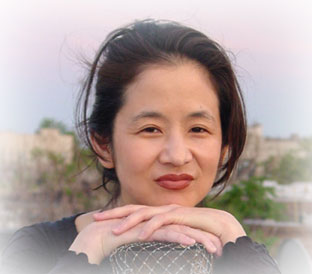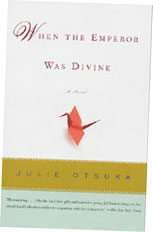|
ASIAN AMERICAN PERSONALITIES
Julie Otsuka survives a failed painting career to write a first novel that leaves critics gasping for fresh superlatives.
|
CONTACT US
|
ADVERTISING INFO
© 1996-2013 Asian Media Group Inc
No part of the contents of this site may be reproduced without prior written permission.
GOLDSEA | ASIAMS.NET | ASIAN AMERICAN PERSONALITIES
Simmering
Perfection
PAGE 1 OF 4
 very first novelist daydreams of having the editors at a prestigious literary house fall in love with the manuscript over a weekend and call Monday with a handsome offer. Julie Otsuka may be the exception. After laboring six and a half years on a slender masterpiece, having kept her own agent waiting three years for a hundred pages, Otsuka emailed her the final chapter without expectations. Only later did she learn that her manuscript had been delivered Friday to an important Knopf editor who called Monday to buy it.
very first novelist daydreams of having the editors at a prestigious literary house fall in love with the manuscript over a weekend and call Monday with a handsome offer. Julie Otsuka may be the exception. After laboring six and a half years on a slender masterpiece, having kept her own agent waiting three years for a hundred pages, Otsuka emailed her the final chapter without expectations. Only later did she learn that her manuscript had been delivered Friday to an important Knopf editor who called Monday to buy it.

DARYL N LONG |
It's a moment that could serve as a fairy-tale ending to Otsuka's two-decade saga as a failed painter who finally finds the right strokes and pigments in English prose. Alternatively, it's an epilogue to a family saga that began six decades and three generations earlier when Otsuka's grandfather was imprisoned with other Japanese immigrants under the baseless suspicion of being a dangerous enemy alien. Otsuka's grandmother and mother were railroaded out to the Utah desert to spend three years encircled by barbed wire. After the war the family returned to salvage lives in a society that had betrayed and robbed them.
The details of that experience came down to Julie Otsuka only as a child's gleanings from adult stories, and later, through her own painstaking research into archives and published accounts. But those who read When the Emperor Was Divine will be convinced that through some alchemy Otsuka has distilled and crystalized the shock, numbness, pain and rage of eighty thousand Japanese Americans.

When the Emperor Was Divine received high praise for its understated tone and evocative powers. |
Otsuka's literary gem has the visual impact of a collection of paintings whose pigments are the small, irreductible words in which Hemingway put so much stock. In scene after scene the novel quietly evokes the rending and crumpling of lives without a single reference to emotion. It renders painstakingly, even lovingly in golden light, the mute minutiae of a historic moment now recognized as one of the ugliest in American history. Wisely avoiding the trap of denouncing an admitted injustice, Otsuka achieves emotional power by making immediate and palpable the internment's effect on a boy, a girl, a mother. Only in the brief, catharctic final chapter does the reader hear a victim's rage. The novel is a small tour de force of evocative power and narrative control. It has been so hailed by everyone from Michiko Kakutani to the survivors of the internment camps themselves.
Julie Otsuka was born May 15, 1962 in Palo Alto, California. Her issei father worked as an aerospace engineer. Her nisei mother worked as a lab technician before giving birth to Julie, then two sons. When Julie was nine the Otsukas moved to Palos Verdes where she did well enough in school to be accepted into Yale. She had intended to study American studies or history but discovered a passion for sculpture and painting. She graduated in 1984 with a B.A. in art, then spent three more years waitressing in New Haven while building up a portfolio. It got her into the MFA program at the University of Indiana. She started in September of 1987 but wilted under the pressure. She left abruptly less than three months later.
After a month at home, Otsuka moved to New York. She learned word processing and found work with a temp agency, then a construction marketing firm. The following year she enrolled in a non-degree program at the New York Studio School of Drawing, Painting and Sculpture. To finance the day program, she continued working nights as a word processor. Two years later she accepted failure as a painter. For the next three years, she spent her days reading at an uptown Manhattan pastry shop. She became enamored of the novelists she calls her “outdoor guys” -- Ernest Hemingway, Richard Ford, Rick Bass, Cormac McCarthy.
Her creative rebirth began as humorous sketches written to amuse herself and a boyfriend. She used the sketches to win admission into Columbia's MFA program in creative writing. She started in 1994. By the time she received her degree in 1999, she had written two and a half chapters of When the Emperor Was Divine. They impressed a top literary agent who agreed to represent Otsuka in 1998. She would have to wait three years for the remaining few pages to trickle in. The hardcover edition was published by Knopf in September of 2002 to universally enthusiastic reviews hailing Otsuka as an elegant stylist of understatement and evocative brilliance. The Anchor Books paperback edition was released in late October, 2003.
GS: You've spoken about having failed as a painter.
JO: I was young and just sort of cracked and couldn't paint any more. So I just left [the University of Indiana]. It was my first serious doubt about my creative abilities.
GS: Did you have a nervous breakdown?
JO: I did have a nervous breakdown.
CONTINUED BELOW
GS: Did you see a psychiatrist?
JO: Right then, no.
GS: So you just left?
JO: I left. Now that I think about it, it would probably have been a good idea to talk to somebody. But I didn't. I just left the scary place. I just ran away.
GS: When had you first become interested in painting?
JO: I had never taken a drawing class or any art class before I arrived at Yale. I really didn't know what I would study there. When I see young kids today, they're all on track and know what they want to do. They want to make good money. They seem very pre-professional these days. I was pretty naive. I thought maybe American studies. I liked history, I liked English. But I took my first drawing class there and I loved it.
My sophomore year I started doing a lot of figurative sculpture. With sculpture, it came to me very naturally and I did seem to have a gift for it. I just loved working from the figure there were long days in the studio, working with clay. I was very happy doing that.
I didn't even start painting until my junior year, so pretty late. I guess I fell in love with the medium of paint. It was a little harder for me than sculpture. It didn't come so easily, but I loved the act of looking and putting down the paint and color. But technically I was not able to do what I wanted to do. I think I became more interested in painting than in sculpture at a certain point.
GS: What were your subjects for sculpture?
JO: It was always working with the figure. Heads. Doing some portrait of heads and moved on to the full figure. I was always working from life. Still life or the view out my window or something in the studio.
GS: Were there any subjects you preferred?
JO: No, I could look at anything. It was the act of looking and how you made something out of paint. It just seemed magical to me. I loved Matisse, Cezanne. He was very interested in the act of looking, like how he painted that mountain again and again and again, and how it was always different for him. How he was always engaged in the act of seeing.
GS: Wasn't that Hemingway's favorite artist?
JO: I don't know, was it? He's one of my favorite writers.
GS: Yes, we know. He said he learned to write from studying Cezanne's paintings.
JO: I especially love Cezanne's late paintings.
GS: Was your style anything like Cezanne?
JO: No, I don't think so. I think I was more into color. Technically maybe I was never a good draftsman, I'm not sure. But I think I have a natural gift for color and mark. I think what happened was that I just got extremely self-conscious. I guess that's what happened in graduate school. I just felt like I was watching myself. And when I got to that point, I just couldn't really go on any more. I think I had been painting unself-consciously for a few years. Certainly while I was at Yale I was immersed in the moment and actually looking and doing and seeing. It felt very immediate. I spent the last couple of years at Yale in the studio all the time.
GS: How did you do academically?
JO: I actually did fine. I always liked writing, so writing was never a problem but I never really thought about it. I could write papers and I enjoyed writing but I had never written anything creative. I never made anything up. It seemed like painting was the harder thing to do. It was really what I loved to do for a long time. I was just more engaged in the process of looking.
PAGE 2
| “I was young and just sort of cracked and couldn't paint any more. It was my first serious doubt about my creative abilities.” |
